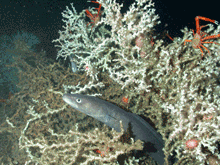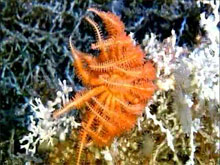
View a slide show of a few of the images of the science activities, exploring the southeastern US (SEUS) and Gulf of Mexico continental slope coral ecosystems during the Life on the Edge Explorations.
![]() Click
image to view a slide show.
Click
image to view a slide show.
Life on the Edge 2005:
Exploring Deep Coral Communities
October 16 - November 4, 2005
Our ongoing studies (2000-present) exploring southeastern US (SEUS) and Gulf of Mexico continental slope coral ecosystems are based on hypotheses that these habitats are ecologically important and productive, yet they are poorly documented. There is increasing evidence that deep water (aphotic) corals are important fish habitat, hold data on ocean climate and productivity, and are hotspots of biodiversity, including new species. Deep coral habitats are more abundant than previously known, and at the same time they are being threatened. The SEUS and Gulf of Mexico may have the most extensive deep coral areas in the US; however, these large regions are poorly explored (even considering recent expeditions). These high profile features may concentrate resources and enhance local productivity in ways similar to seamounts. Also, like seamounts, such unique habitats have escaped detailed examination in the SEUS not only because of their great depths but also because the bottom topography is rugged and the habitats are overlain by extreme currents (i.e., Gulf Stream). Thus, most studies on deep coral banks require expensive unconventional sampling techniques (e.g., manned submersibles). Locating, describing, and mapping deep corals and conducting basic biological studies in these habitats are priorities for our research. Our previous cruises have documented deep coral and outer shelf reef habitats and associated biota, but these missions have only begun to quantify this extensive habitat in the region. Our studies have yielded many new records of biota, new ecological data, new data on habitat distributions/structures, and data on water column trophic connectivity. This cruise continues and expands our explorations of these unique and relatively unknown deep water habitats.
While the SEUS harbors many deep coral species, few create extensive, complex reef structures. Lophelia pertusa, the major mound forming coral in the deep sea, is a cosmopolitan species and is the dominant hard coral deeper than 300 m through the SEUS and Gulf of Mexico. We have concentrated our work around L. pertusa areas (because of its abundance, wide distribution, and structure forming abilities), but our objectives also apply to most hard substrate habitats including mixed corals and sponges.We will locate and sample poorly studied middle slope coral banks (Lophelia mostly, 360-800 m) from Cape Lookout, NC to southeastern FL (see Mission Plan). During this expedition we will cover over 650 nautical miles (1,205 km). We will use a manned submersible (Johnson-Sea-Link, JSL) to quantify biota and habitat on and near reefs via standardized video observations. The JSL will collect samples of corals and associated invertebrates for various purposes. Each dive will have multiple objectives, with some tasks given priority. We will also sample the whole water column using a variety of ship deployed nets. As an integrated regional exploration of deep coral habitat physical structure and ecology, this interconnected, multidisciplinary approach should advance our understanding of critical habitats. Using standardized methods throughout this large area will allow us to compare complex habitats over depth and geographic regions.
Updates & Logs
Click images or links below for detailed mission logs.
 Nov 1, 2005 This day's dives off the coast of Jacksonville documentated the changing environment as we moved southward. Each dive continues to provide a wealth of information.
Nov 1, 2005 This day's dives off the coast of Jacksonville documentated the changing environment as we moved southward. Each dive continues to provide a wealth of information. Oct 31, 2005 The ocean is commonly thought to be composed of different layers. But, in fact, these surface to bottom communities are interconnected.
Oct 31, 2005 The ocean is commonly thought to be composed of different layers. But, in fact, these surface to bottom communities are interconnected. Oct 30, 2005 It is amazing how little direct observation data we have for the deep ocean (below SCUBA depth). One of the goals of this mission is to fill in that data gap.
Oct 30, 2005 It is amazing how little direct observation data we have for the deep ocean (below SCUBA depth). One of the goals of this mission is to fill in that data gap. Oct 29, 2005 Through our collections and observations, we gain a better understanding of the biodiversity and habitat associations of the organisms utilizing the Lophelia reefs.
Oct 29, 2005 Through our collections and observations, we gain a better understanding of the biodiversity and habitat associations of the organisms utilizing the Lophelia reefs. Oct 28, 2005 The dives today on Stetson Banks demonstrated the need to take multiple dives at each study site to document the diverse habitat and organisms in this region.
Oct 28, 2005 The dives today on Stetson Banks demonstrated the need to take multiple dives at each study site to document the diverse habitat and organisms in this region. Oct 27, 2005 After three days lost due to the hurricane, Dr. Steve Ross is glad to get back in the groove and resume diving operations.
Oct 27, 2005 After three days lost due to the hurricane, Dr. Steve Ross is glad to get back in the groove and resume diving operations.  Oct 26, 2005 While stuck in port due to Hurricane Wilma,
the crew visits with the media before
heading back to sea.
Oct 26, 2005 While stuck in port due to Hurricane Wilma,
the crew visits with the media before
heading back to sea. Oct 24, 2005 After more than a week on the R/V Seward Johnson, an Educator-at-Sea has had all her preconceived notions of life at sea dispelled by actual experience.
Oct 24, 2005 After more than a week on the R/V Seward Johnson, an Educator-at-Sea has had all her preconceived notions of life at sea dispelled by actual experience. Oct 23, 2005 Data management is one of the most important jobs during a research cruise and is critical to future analyses.
Oct 23, 2005 Data management is one of the most important jobs during a research cruise and is critical to future analyses.  Oct 22, 2005 The Life on the Edge team is busy around the clock. The members of the night crew pull samples from the sea while the rest of the ship sleeps.
Oct 22, 2005 The Life on the Edge team is busy around the clock. The members of the night crew pull samples from the sea while the rest of the ship sleeps. Oct 21, 2005 After some trial and error, the team masters the art and science of nightlight fishing.
Oct 21, 2005 After some trial and error, the team masters the art and science of nightlight fishing. Oct 20, 2005 A marine biologist from Scotland has his first look at cold-water coral reefs from the Johnson-Sea-Link submersible.
Oct 20, 2005 A marine biologist from Scotland has his first look at cold-water coral reefs from the Johnson-Sea-Link submersible. Oct 19, 2005 Discover the unique tools and advanced computer technology behind the science of seafloor mapping.
Oct 19, 2005 Discover the unique tools and advanced computer technology behind the science of seafloor mapping. Oct 18, 2005 Today's dives were in a new area off Cape Lookout and investigated large coral bank systems clustered around an undersea ridge.
Oct 18, 2005 Today's dives were in a new area off Cape Lookout and investigated large coral bank systems clustered around an undersea ridge. Oct 17, 2005 The Johnson Sea-Link submersible slipped beneath the waves for the first dive of the expedition and encountered a bignose shark and brought back lots of samples, including a fish that "walks around" on its fins.
Oct 17, 2005 The Johnson Sea-Link submersible slipped beneath the waves for the first dive of the expedition and encountered a bignose shark and brought back lots of samples, including a fish that "walks around" on its fins. Oct 16, 2005 Life on the Edge 2005 is underway! After setting sail from Morehead City, NC, the first marine samples were scooped from the sea at 11:30 PM.
Oct 16, 2005 Life on the Edge 2005 is underway! After setting sail from Morehead City, NC, the first marine samples were scooped from the sea at 11:30 PM.


























